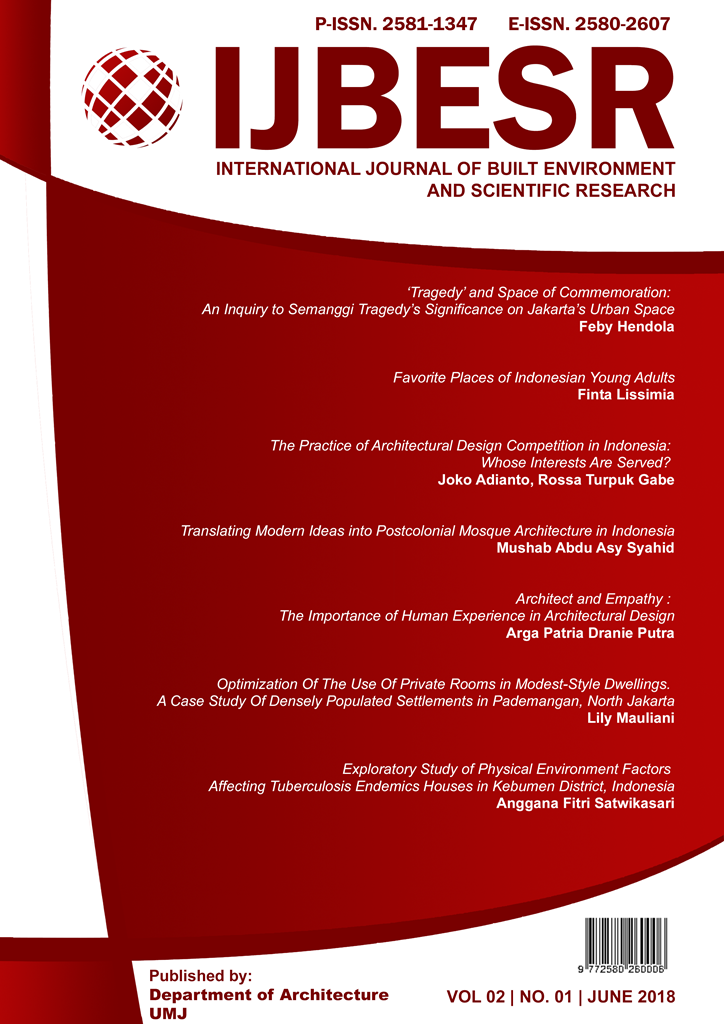Favorite Places of Indonesian Young Adults
DOI:
https://doi.org/10.24853/ijbesr.2.1.15-26Keywords:
age group, favorite place, Indonesia, young adultsAbstract
Study on favorite places reflects people’s preference for particular place. It may result in most likeable type of place and even the driving factors. Favorite place study can become the base for further research about preference. This type of study is very beneficial for spatial planning to find out what kind of setting will be successful. The purpose was to find out favorite place of young adult, specifically Indonesian people. Respondents in this study are restricted to 25-40 years old to produce strong result. In order to achieve this purpose, respondents will be asked about their favorite place. Data collected will be analyzed using distribution. There are 347 answers that can be analyzed further. Result show that favorite place of Indonesian young adults mostly are restaurants and beaches. It may have to do with lifestyle and geography of the area.References
Korpela, K.M., Hartig, T., Kaiser, F.G., Fuhrer, U. Restorative Experience and Self Regulation in Favorite Place. Journal of Environment and Behavior Vol.33 No.4, July 2001, 572-589.
Newell, P.B. A Cross Cultural Examination of Favorite Place. Journal of Environment and Behavior Vol. 29 No. 4, July 1997, pp.495-514
Korpela, K.M. Negative Mood and Adult Place Preference, Journal of Environment and Behavior Vol. 35 No. 3, May 2003, pp.331-346
Sari, A.A, Kusuma, H.E, Tedjo, B. Tempat favorit Mahasiswa Sebagai Sarana Restorative. Jurnal Lingkungan Binaaan Vol. 1 No.1, 2012, 1-14
Chapman, J.A., Robertson, M. Adolescents Favourite Places : Redefining the Boundaries beteween Private and Public Space. Space and Culture 12(4). 2009, 419-434
Lissimia, F. Kusuma, H.E. Karakter Fisik Spasial Tempat Favorit Dewasa Muda. Temu Ilmiah IPLBI 2013, p 9-24
Malinowski, J.C., Thurber, C.A. Developmental Shifts in the Place Preferences for Boys Aged 8-16 Years. Journal of Environmental Psychology 16, 1996, 45-54
Berk, L. E. Development through the lifespan (4th Ed.) Chapter 14. Allyn and Bacon: Boston, MA. 2007.
Sokol, J.T. Identity Development Throughout the Lifetime: An Examination of Eriksonian Theory. Graduate. Journal of Counseling Psychology: Vol. 1: Iss. 2, Article 14. 2009.
Murdy, J.J., Gibson, H.J., Yiannakis, A. Predicting Nature-Based Tourist Roles: A Life Span Perspective. Proceedings of the 2002 Northeastern Recreation Research Symposium, 2002, 179-183.
Bechtel, R.B., Churchman, A. Handbook of Environmental Psychology. John Wiley & Sons, Inc., New York. 2002.
Najafi, M., Shariff, M.K.B.M. The Concept of Place and Sense of Place In Architectural Studies. World Academy of Science, Engineering and Technology 56. 2011, 187-193.
Creswell, J.W. Research Design: Qualitative, Quantitative, and Mixed Methods Approaches. California: SAGE Publications, Inc. 2003.
Galindo, M.P.G., & Rodriguez, J.A.C., Environmental Aesthetic and Psychological Wellbeing : Relationship Between Preference Judgements for Urban Landscapes and Other Relevant Affective Response. Psychology in Spain. Vol.4. No.1. 2000, 13-27







